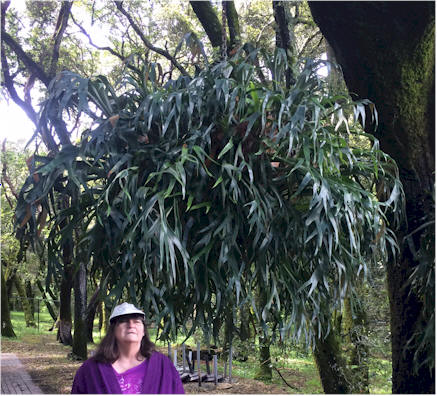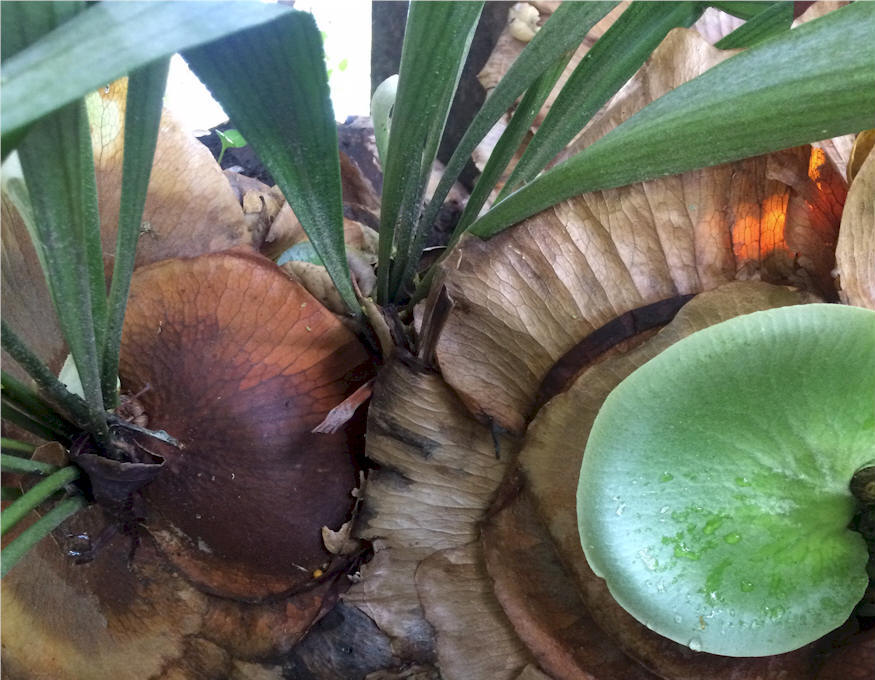
Platycerium Yanid Willinckii & Hillii (Hybrid) |
| A little known platycerium is the
Platycerium Yanid hybrid which is a cross between Platycerium
willinckii and Platycerium hillii. The plant above is at
least 50 years old, and possibly 100 years old. It is hanging along
with a dozen more large examples at the Filoli Garden in Woodside CA.
The Filoli Gardens are a famous estate built by the Bourn family in 1915
and sold to the Roth family until donated to the National Trust for
Historic Preservation in 1975. When the Platycerium Yanid
were added is not known
The plants photographed had most of the tops of the shield fronds trimmed back by the gardeners. One might wonder why? But if you consider the plant shield fronds form a ball like Platycerium hillii, you will recognize the shield fronds grow inward to form a ball and provide protection from over watering. The gardeners have opened up the ball to allow rain water to freely enter the plant. The fact excess water does not appear to harm the plant possibly stems from its Platycerium willinckii herritage which forms a basket.
One thing that is surprising is this plants resistance to cold. In Woodside the temperature frequently frequently drops below freezing for short periods during the winter and these platyceriums are probably too large to move inside on cold nights. One reason they have survived is the large root ball, whereas a smaller less established plant would probably not have survived. |
| The reader must realize that many hybrids are a result of accidental mixing of spore when similar plants are grown in close proximity. Even when spore from two species are intentionally crossed, it is always possible for a spore from an unintended species to contaminate the intended cross. After repeated attempts and proof that their progeny have the same traits, then we can agree as to the parentage and define it as a new hybrid and not just a sport or cultivar of a species. This can take a long time with slow growing platyceriums and experienced growers are hesitant to jump the gun and name a hybrid. So when we discuss hybrids, we need to consider all the variables. Soon we will have more definite DNA studies. Until DNA testing is more readily available, and established parent base lines defined, we must look at and compare traits from other species and deduct a logical inference to the actual parentage and these are considered individual plants and not necessarily a hybrid. |
|
[ Home ] |
 When
first observing the platyceriums, one would suspect they are
Platycerium bifurcatums. But closer look shows the fertile
fronds are growing out from the bud in an edgewise manor. Then hangs
down in a ratty manor. This suggests the plant is a Platycerium
willinckii. Another trait of the Platycerium willinckii
is tall deeply lobed shield fronds. However as shown in the photo on
the right, the shield fronds are rounded and not tall and deeply lobed.
The rounded shield fronds are a Platycerium hillii trait. So
this author concludes it is a cross of the Platycerium willinckii
and Platycerium hillii called a Platycerium yanid.
When
first observing the platyceriums, one would suspect they are
Platycerium bifurcatums. But closer look shows the fertile
fronds are growing out from the bud in an edgewise manor. Then hangs
down in a ratty manor. This suggests the plant is a Platycerium
willinckii. Another trait of the Platycerium willinckii
is tall deeply lobed shield fronds. However as shown in the photo on
the right, the shield fronds are rounded and not tall and deeply lobed.
The rounded shield fronds are a Platycerium hillii trait. So
this author concludes it is a cross of the Platycerium willinckii
and Platycerium hillii called a Platycerium yanid.